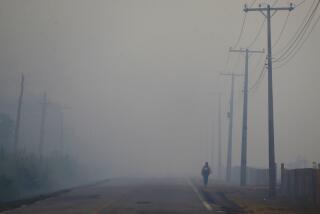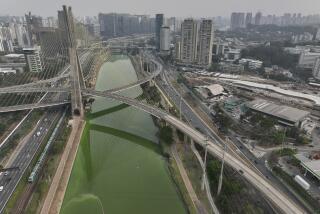Serious Climatic Risks for Brazil Cited : Scientists Decry Deforestation of Vast Areas in Amazon
- Share via
SAO PAULO, Brazil — Vast areas are being stripped from the Brazilian Amazon, the world’s largest tropical forest, but an increasing number of scientists are calling it progress without a plan.
They warn that the development drive holds serious climatic and other risks for Brazil.
Estimates of the area bulldozed and burned over the past 20 years to make way for cattle ranches, hydroelectric and mining projects, range from 5% to 10% of the 1.9 million square miles the forest once covered.
The rate of clearance is accelerating as Brazil pushes to conquer its last remaining frontier to boost agricultural output and exploit known mineral reserves.
Scientists say too little attention is being paid to channelling agricultural development into suitable areas, with the result that land is often abandoned as unproductive soon after it is cleared.
U.S. Scientist’s View
“Unique forests are being destroyed just to give a few years cattle grazing,” commented one U.S. scientist attending a recent international conference on the Amazon.
Scientists say more research is urgently needed into the long-term consequences of the extensive deforestation of the Amazon with its spectacular diversity of plant life.
“Nobody is saying there should be no development of the Amazon, but the questions are just where and how much,” said Philip Fearnside, a U.S. scientist living in Brazil who has spent the last nine years studying the region.
He added, “The development needs to be much more rational than it has been up to now.”
While the forest is undoubtedly mineral rich--the recently inaugurated Carajas project contains the world’s largest iron ore deposits--most of its soil is poor.
“The luxuriance of the Amazon is an optical illusion,” said Gerardo Budowski from Costa Rica’s Center for the Investigation and Teaching of Agronomy.
Lack of Ideal Soil
Up to 170 different species of tree can be found in one hectare of the Amazon against a few dozen in the whole of an average state of the United States, but only 10% of its soils are considered ideal for agriculture.
The idea that the Amazon is vital to the world’s oxygen supply has been debunked: the forest consumes as much as it produces. But not enough is yet known about it’s climatic influence beyond the immediate region, scientists say.
For Eneas Salati, former director of the Institute for Amazonian Studies, the Amazon is a “rain-factory” in which 50 % of the precipitation that falls is evaporated directly back into the air to form clouds and more rain.
Large-scale clearing would thus almost certainly bring climatic changes within the Amazon and Brazilian agricultural areas to the south, as well as affecting the volume of the rivers in the Amazon basin.
Another unknown factor concerns the impact on the atmosphere of extensive burning of the trees, which is calculated to produce 800 tons of carbon dioxide for every hectare cleared.
10-Week Conference
Budowski and Salati were among international scientists at a 10-week conference on climatic, biotic and human interactions in the Amazon held at Brazil’s space research center outside Sao Paulo.
The meeting, organized by the Tokyo-based U.N. University, said that while more research was urgently needed, work already done pointed to the “potentially serious consequences” of the accelerating deforestation. It called for greater control.
No official survey has been carried out into the extent of deforestation in the Brazilian Amazon, which contains a third of the world’s tropical rain forest, since 1978 when a government study using satellite pictures showed 1.55%, or 30,000 square miles, had been cleared.
Advocates of the Amazon’s rapid development use the fact that this was only a relatively small area to attack their opponents as alarmist, Fearnside said.
But the survey also showed the startling speed at which the region was being occupied. A similar study three years before had revealed only 7,700 square miles of cleared land.
If clearance were to continue at that rate, the whole of the forest could disappear within 30 years, Fearnside said.
Road-Building Program
The flow of immigrants, including rural workers forced off the land in Brazil’s southern grain belt by mechanized farming, began with a road-building program in the mid-1960s.
More to Read
Sign up for Essential California
The most important California stories and recommendations in your inbox every morning.
You may occasionally receive promotional content from the Los Angeles Times.










